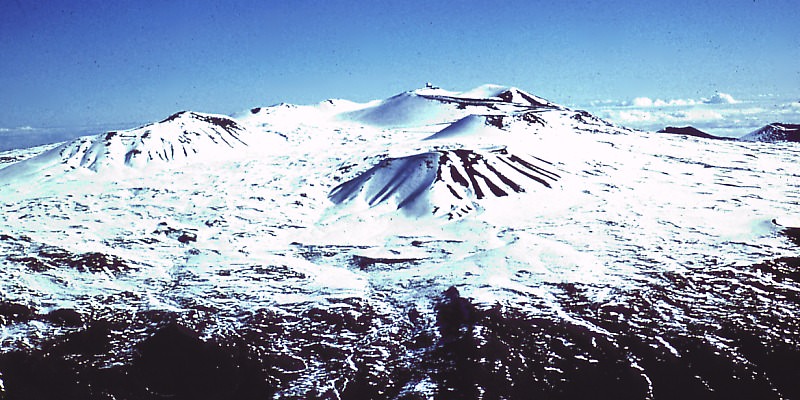

Mauna Kea. Image credit: USGS
[/caption]
The shield volcano Mauna Kea is the tallest volcano on Earth, rising to a summit of 4,205 meters above sea level. It’s one of the 5 volcanoes that make up the Big Island of Hawaii. Mauna Kea means “white mountain” in the Hawaiian language because its summit is regularly covered in snow during the winter.
Scientists believe that Mauna Kea began erupting about 1 million years ago. It’s fed by magma from the Hawaiian hotspot; a volcanic vent that continues to pump out magma while the Pacific Plate slowly moves over top of it. This has created a chain of islands thousands of kilometers long called the Hawaiian archipelago. It’s believed that Mauna Kea transitioned from an active volcano to a post-shield stage of volcanic evolution about 200,000 to 250,000 years ago. The last eruption was thought to have occurred about 4000-5000 years ago.
Because of its high altitude, the peak of Mauna Kea is an excellent spot for astronomical observing. The summit of the volcano is above 40% of the Earth’s atmosphere, and 90% of the water vapor, allowing for extremely clear skies. Some of the largest, most powerful telescopes in the world are located atop Mauna Kea, including the Keck observatories, and the Gemini North telescope.
During the winter, Mauna Kea is coated in a thin layer of snow, and there are regions on the mountain where you can ski or snowmobile. And scientists have discovered evidence that large glaciers formed during the last period of world wide glaciation – about 11,000 years ago.
We have written many articles about volcanoes for Universe Today. Here’s an article about Mauna Loa, and here’s an article about Kilauea.
Want more resources on the Earth? Here’s a link to NASA’s Human Spaceflight page, and here’s NASA’s Visible Earth.
We have also recorded an episode of Astronomy Cast about Earth, as part of our tour through the Solar System – Episode 51: Earth.
Some exoplanets have characteristics totally alien to our Solar System. Hot Jupiters are one such…
Stars form in Giant Molecular Clouds (GMCs), vast clouds of mostly hydrogen that can span…
Let’s dive into one of those cosmic curiosities that's bound to blow your mind: how…
The majority of the universe remains unmapped, but we have a potential window into it…
NASA engineers are pressing ahead with preparations for the Artemis II mission unless someone tells…
It’s not uncommon for space missions to be tested here on planet Earth. With the…